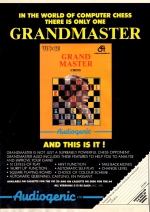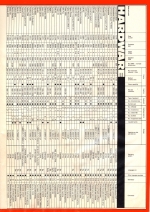
Personal Computer News
 3rd March 1984
3rd March 1984
Author: Peter Scott
Published in Personal Computer News #051
Take on the role of Morris the millipede in this Acorn Electron game.
Introduction
Millipede is a fast arcade style game written for the Acorn Electron by Peter Scott of Bedlington, Northumberland. Since it was written on the Electron, it will run on both the BBC Model B or expanded Model A (at a higher speed to boot).
Gameplay
You play the part of Morris the millipede; the object of the game is simply to keep alive as long as possible and eat as much as you can. Millipedes, as everyone knows, have a voracious appetite. The food comes in the form of green diamonds and bonus crosses. It is not possible to eat the multi-coloured obstacles or your own body. Trying to eat these or the edges of the screen gives Morris terminal indigestion and is not recommended.
Twenty points are awarded for eating a diamond and 75 points for a cross. A bonus life is awarded if you pass level five and there are nine levels in all.
The author gives the following hints on getting a good score: "Only press a key when you want to change direction, as the millipede keeps going regardless. Start on level nine and graduate up through the skill levels as you get better. Don't take too many risks, especially towards the end of the screen as you get bonus points depending on the length you have attained."
Program Notes
| 9 | This line can read ON ERROR GOTO 173 |
|
| 15-23 | Main game loop | |
| 27 | Function to read a character on the screen | |
| 31 | Procedure to pause for a while | |
| 35 | Print the score in format 00750 | |
| 36 | Print the level in the form 03 | |
| 43 | Main game loop | |
| 44 | Check the keyboard and change direction accordingly | |
| 46 | Move the millipede | |
| 47 | Call screen sense procedure - check if you've hit an obstacle or food | |
| 48 | Hit a bonus cross | |
| 49 | Print centipede, update position array, make sound and reduce time | |
| 50 | If a random condition is met then print cross | |
| 51 | Check if you are dead, print food if you aren't | |
| 56 | You are dead | |
| 58 | If all lives are gone then end the game | |
| 60-62 | Explode the millipede then erase it | |
| 69 | Pause until you press a key | |
| 74 | Completed this screen | |
| 77 | Work out your length and if greater than 1 add a bonus | |
| 82 | You're past level 5 - add a life | |
| 87 | Draw the screen - change all colours to black to hide printing | |
| 91 | Work out the delay for this screen | |
| 92 | Randomise the random generator, set up the variables | |
| 100 | Start the game | |
| 106 | All your lives are up | |
| 107 | Rub out the screen | |
| 109 | Inquest on your performance | |
| 110 | You are on the high score table | |
| 115 | Start the printing of the high score table | |
| 126 | Input your name and rank on the high score table | |
| 131 | Swap variables for the score table | |
| 135 | Print instructions in MODE 4 | |
| 145 | Input whether you want sound or not | |
| 149 | Input the skill level | |
| 153 | Initialise the game | |
| 158 | Set the logical colours | |
| 159-160 | Define the graphics characters | |
| 161-164 | Set up some variables | |
| 165 | Define the sound envelopes | |
| 166-167 | Define colour variables and obstacle rising | |
| 173 | Error - is it an escapel if it is then go back to the instructions and reset the score | |
| 174 | Print the error and reset the computer to normal: END. | |
This article was converted to a web page from the following pages of Personal Computer News #051.






